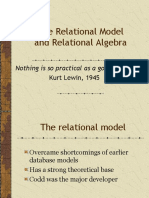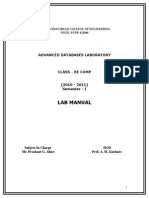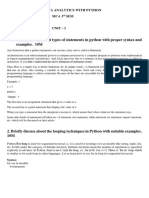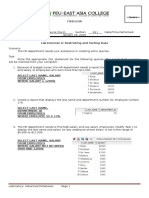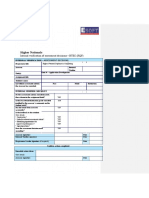Data Modeling Using The Entity-Relationship Model
Data Modeling Using The Entity-Relationship Model
Uploaded by
Vineet GuptaCopyright:
Available Formats
Data Modeling Using The Entity-Relationship Model
Data Modeling Using The Entity-Relationship Model
Uploaded by
Vineet GuptaOriginal Description:
Original Title
Copyright
Available Formats
Share this document
Did you find this document useful?
Is this content inappropriate?
Copyright:
Available Formats
Data Modeling Using The Entity-Relationship Model
Data Modeling Using The Entity-Relationship Model
Uploaded by
Vineet GuptaCopyright:
Available Formats
Chapter 3 1
Chapter 3
Data Modeling Using the
Entity-Relationship Model
Chapter 3 2
Chapter 3 3
Entity-Relationship(ER) Model
The ER model is a high-level conceptual
data model. It has not been implemented in
any commercial DBMS (?), but is a
powerful short hand often used in database
design for a first rendition of the miniworld.
The ER model was introduced by Peter
Chen in 1976, and is now the most widely
used conceptual data model.
Chapter 3 4
Entity-Relationship(ER) Model
(cont)
Much work has been done on the ER model,
and various extensions and enhancements
have been proposed (see Ch. 21 and the text
Conceptual Database Design by
Batini/Ceri/Navathe, Benjamin Commings).
Chapter 3 5
Definitions
An entity is an object in the miniworld.
An attribute of an entity can have a value
from a value set (domain)
Each entity belongs to some one entity type
s.t. entities in one entity type have the same
attributes (so each entity type is a set of
similar entities).
Chapter 3 6
Definitions (cont)
A key attribute of an entity type is one
whose value uniquely identifies an entity of
that type.
A combination of attributes may form a
composite key.
If there is no applicable value for an
attribute that attribute is set to a null value.
Chapter 3 7
Entity Type / Entity Set
Entity Type (Intension): EMPLOYEE
Attributes: Name, Age, Salary
Entity Set (Extension):
e
1
= (John Smith, 55, 80000)
e
2
= (Joe Doe, 40, 20000)
e
3
= (Jane Doe, 27, 30000)
.
.
.
Chapter 3 8
Attributes
Attributes can be
composite / simple (atomic)
single-valued / multivalued
stored / derived
key / nonkey.
Chapter 3 9
Attribute Examples
Name = John Doe
Birthdate = May 10, 1989
Age = 9
Degree = null
SSN = 123456789
Name = John Doe
Birthdate = May 10
Birthyear = 1989
Age = 9
Degree = null
SSN = 123456789
Name = Jane Doe
Birthdate = July 11, 1960
Age = 38
Degree = B.S., M.S.
SSN = 987654321
Chapter 3 10
Chapter 3 11
EMPLOYEE
Name, SSN, Sex, Address, Salary, Birthdate, Department,
Supervisor, {Works on ( Project, Hours)}
WORKS_FOR
EMPLOYEE DEPARTMENT
1 N
Name SSN . . .
Relationship instances of WORKS_FOR:
{(KV, CS), (Pan, EE), . . .}
Chapter 3 12
ER Diagram for COMPANY Database
Chapter 3 13
Relationship Type
A relationship type R among n entity types
E
1
,,E
n
is a set of relationship instances r
i
,
where each r
i
associates n entities (e
1
,,e
n
),
s.t. each e
j
E
j
. Informally, a relationship
instance is an association of entities, with
exactly one entity from each participating
entity type.
Chapter 3 14
Relationship Type (cont)
The degree n of a relationship type is the
number of participating entity types.
In the ER model relationships are explicitly
represented.
Chapter 3 15
Entity Roles
Each entity type in a relationship type plays a
particular role that is described by a role
name. Role names are especially important in
recursive relationship types where the same
entity participates in more than one role:
Employee
Supervision
Supervisor 1 N Supervisee
Chapter 3 16
Weak Entity Type
A weak entity type is one without any key
attributes of its own. Entities belonging to a
weak entity type are identified by being related
to another entity type ( called identifying
owner) through a relationship type ( called
identifying relationship), in combination with
values of a set of its own attributes (called
partial key). A weak entity type has total
participation constraint w.r.t. its identifying
relationship.
Chapter 3 17
Relationship Attributes
Relationship types can have attributes as
well. in case of 1:1 or 1:N relationships,
attributes can be migrated to one of the
participating entity types.
Chapter 3 18
Relationship
Chapter 3 19
Relationship (cont)
Chapter 3 20
Relationship (cont)
Chapter 3 21
Fig 3.12
Chapter 3 22
Fig 3.13
Chapter 3 23
Structural Constraints
Structural constraints of a relationship type:
Cardinality ratio: Limits the number of
relationship instances an entity can participate
in, eg. 1:1, 1:N, M:N
Participation constraint: If each entity of an
entity type is required to participate in some
instance of a relationship type, then that
participation is total; otherwise, it is partial.
Chapter 3 24
Structural Constraint Min, Max
A more complete specification of the
structural constraint on a relationship type
can be given by the integer pair (min, max),
which means an entity must participate in at
least min and at most max relationship
instances.
Chapter 3 25
Chapter 3 26
A ternary relationship generally represents
more information than 3 binary relationships
Chapter 3 27
Chapter 3 28
A Weak Entity with a Terary
Identifying Relationship
You might also like
- Lesson 2 - Class DiagramsDocument50 pagesLesson 2 - Class DiagramskasunNo ratings yet
- Mtctce 2Document5 pagesMtctce 2Henrry Soto100% (1)
- Centura Builder - Function ReferenceDocument422 pagesCentura Builder - Function ReferenceKenett Serrano100% (4)
- Relationships Among ClassesDocument20 pagesRelationships Among ClassesKilian Fernando Hernandez FlorianNo ratings yet
- Three Tier DBMS ArchitectureDocument8 pagesThree Tier DBMS ArchitectureNikhil BharadwajNo ratings yet
- 1 3 2 RelationshipAmongClassesDocument10 pages1 3 2 RelationshipAmongClassesVijay VikrantNo ratings yet
- Data Models, Schemas & InstancesDocument20 pagesData Models, Schemas & InstancesRoger SamNo ratings yet
- Data Structure and Oops in C++Document35 pagesData Structure and Oops in C++boomijaNo ratings yet
- ch-9 Advanced ClassesDocument28 pagesch-9 Advanced ClassesbhargaviNo ratings yet
- Database Management System CS-116: E-R ModelDocument76 pagesDatabase Management System CS-116: E-R ModelHarjyot SinghNo ratings yet
- Solution To Assi1Document8 pagesSolution To Assi1Yogesh GandhiNo ratings yet
- Dbms Lab Manual-2018Document57 pagesDbms Lab Manual-2018shruti kukkarNo ratings yet
- ADBMS Lab ManualDocument69 pagesADBMS Lab ManualAmit Sangale100% (1)
- Chapter 6. Data ModelingDocument37 pagesChapter 6. Data ModelingVy NguyễnNo ratings yet
- Query Processing - Database Questions & Answers - Sanfoundry 00Document7 pagesQuery Processing - Database Questions & Answers - Sanfoundry 00abdul rehmanNo ratings yet
- Ooad Unit3 NotesDocument15 pagesOoad Unit3 NotesplutopopNo ratings yet
- The Relational Model and Relational Algebra: Nothing Is So Practical As A Good TheoryDocument26 pagesThe Relational Model and Relational Algebra: Nothing Is So Practical As A Good TheoryrajduttNo ratings yet
- SQL SERVER Weekly Test2 Complex QuestionsDocument24 pagesSQL SERVER Weekly Test2 Complex QuestionsManish SinghNo ratings yet
- DBMS Unit 3Document85 pagesDBMS Unit 3Risabh ShuklaNo ratings yet
- DBMS Module-1 PPT UpdatedDocument100 pagesDBMS Module-1 PPT UpdatedHarsshithaNo ratings yet
- Tinywow DBMS Full Notes 71477453Document49 pagesTinywow DBMS Full Notes 71477453akashjais1187No ratings yet
- DBMS Chapter 4Document39 pagesDBMS Chapter 4Nabin ShresthaNo ratings yet
- Unit1 Class DiagramDocument83 pagesUnit1 Class DiagramCandi MiddletonNo ratings yet
- Er Diagram For DBMSDocument17 pagesEr Diagram For DBMSTahir MuriNo ratings yet
- DBMS - R18 UNIT 1 NotesDocument25 pagesDBMS - R18 UNIT 1 NotesKalyan KarmakondaNo ratings yet
- 10 Total Mark: 10 X 1 10: NPTEL Online Certification Courses Indian Institute of Technology KharagpurDocument7 pages10 Total Mark: 10 X 1 10: NPTEL Online Certification Courses Indian Institute of Technology KharagpurvitNo ratings yet
- Software Engineering Notes (Unit-III)Document21 pagesSoftware Engineering Notes (Unit-III)Fawaaz ShareefNo ratings yet
- Triggers - SQL Server - CodeProjectDocument5 pagesTriggers - SQL Server - CodeProjectmasterpiecemanishNo ratings yet
- Chapter 7: Entity-Relationship ModelDocument74 pagesChapter 7: Entity-Relationship ModelJatinNo ratings yet
- Dbms Question Bank2 Marks 16 MarksDocument31 pagesDbms Question Bank2 Marks 16 MarksAppandai RajanNo ratings yet
- Database Administration & Management: Introduction To CourseDocument20 pagesDatabase Administration & Management: Introduction To CourseTalal Ramzan GujjarNo ratings yet
- Anna University, Chennai Non-Autonomous Affiliated Colleges Regulations 2021 Choice Based Credit System B.E. Computer Science and EngineeringDocument86 pagesAnna University, Chennai Non-Autonomous Affiliated Colleges Regulations 2021 Choice Based Credit System B.E. Computer Science and EngineeringGowtham Kumar VNo ratings yet
- OOMD QuestionsDocument5 pagesOOMD QuestionsPavan DongrayNo ratings yet
- Model Question PaperDocument2 pagesModel Question PaperLuke KennyNo ratings yet
- Object Relational DBMSsDocument34 pagesObject Relational DBMSsadityatjNo ratings yet
- What Is Relational ModelDocument7 pagesWhat Is Relational ModelfatimaNo ratings yet
- DBMS Lab ManualDocument6 pagesDBMS Lab ManualMuralidhar PaiNo ratings yet
- System Diagrams UMLDocument97 pagesSystem Diagrams UMLdesai_652210782No ratings yet
- R2017 OOAD Unit-2Document45 pagesR2017 OOAD Unit-2Shiva RanjaniNo ratings yet
- DBDM 16 Marks All 5 UnitsDocument74 pagesDBDM 16 Marks All 5 Unitsathirayan85No ratings yet
- 90 (Informatics Practices)Document12 pages90 (Informatics Practices)Tech GuyNo ratings yet
- Evolution of DatabaseDocument15 pagesEvolution of DatabaseKristel Jen E. RosalesNo ratings yet
- Adina Institute of Science & Technology: Department of Computer Science & Engg. M.Tech CSE-II Sem Lab Manuals MCSE - 203Document22 pagesAdina Institute of Science & Technology: Department of Computer Science & Engg. M.Tech CSE-II Sem Lab Manuals MCSE - 203rajneesh pachouriNo ratings yet
- DBMS Lab Manual-CseDocument45 pagesDBMS Lab Manual-Cse20BECSE028 KIRUBANANDHAM KNo ratings yet
- DeadLock in Operating SystemDocument15 pagesDeadLock in Operating SystemMonika SNo ratings yet
- 10 - Relational Model ConceptsDocument15 pages10 - Relational Model ConceptsFahad KhosaNo ratings yet
- Database Management SystemsDocument2 pagesDatabase Management SystemschatnarenNo ratings yet
- Relational AlgebraDocument40 pagesRelational AlgebraTrijit Goswami100% (1)
- Function Oriented DesignDocument10 pagesFunction Oriented DesignKuhoo AgrawalNo ratings yet
- UML DIfferences, Short NotesDocument37 pagesUML DIfferences, Short NotesAshish SinghNo ratings yet
- Dept of Computer Science & Engineering LAB Manual For 2008 - 2009 (II - II) 1Document80 pagesDept of Computer Science & Engineering LAB Manual For 2008 - 2009 (II - II) 1Sai Chaitanya VundrakondaNo ratings yet
- DBMS in 5 HoursDocument332 pagesDBMS in 5 HoursSrujana Kurella100% (1)
- Chapter 3-Database Systems Eighth Edition PresentationDocument55 pagesChapter 3-Database Systems Eighth Edition PresentationAhsen DerseNo ratings yet
- DBMS TM Relational Model Chapter3 (II)Document67 pagesDBMS TM Relational Model Chapter3 (II)MITMCA100% (1)
- Rdbms LC LabguideDocument0 pagesRdbms LC LabguideAlberto HernandezNo ratings yet
- BC0041 Fundamentals of Database Management Paper 2Document16 pagesBC0041 Fundamentals of Database Management Paper 2SeekEducationNo ratings yet
- Dev Answer KeyDocument17 pagesDev Answer Keyjayapriya kce100% (1)
- ADBMS Lab Manual NewDocument24 pagesADBMS Lab Manual NewAshish DugarNo ratings yet
- DDM Question Bank @Document20 pagesDDM Question Bank @vj861647100% (1)
- Python Notes 3rd McaDocument99 pagesPython Notes 3rd McaarjunNo ratings yet
- Study Experiment OOAD LabDocument14 pagesStudy Experiment OOAD Labthebhas1954No ratings yet
- Unit-2.3 PPT Basic Behavioural ModelingDocument71 pagesUnit-2.3 PPT Basic Behavioural Modelingharshit aggarwalNo ratings yet
- CCNA 1 v7.0 Final Exam Answers Full - Introduction To NetworksDocument49 pagesCCNA 1 v7.0 Final Exam Answers Full - Introduction To NetworksChristian StyriaNo ratings yet
- ThesisDocument20 pagesThesisLuigi VanacoreNo ratings yet
- CASESTUDYDocument8 pagesCASESTUDYNitish RoyalNo ratings yet
- GX20 - Hardware Configurator ManualDocument165 pagesGX20 - Hardware Configurator Manualpacipnuippnu19541955No ratings yet
- Smart Home Controlled Using Google AssistantDocument13 pagesSmart Home Controlled Using Google AssistantRachana ChouguleNo ratings yet
- Unary Operator and Binary Operator OverloadingDocument8 pagesUnary Operator and Binary Operator OverloadingLavanya SinhaNo ratings yet
- 3BTG811796-3024 Functional Description - PP - UMCLibDocument17 pages3BTG811796-3024 Functional Description - PP - UMCLibJosé M. Torres B.No ratings yet
- Xsan 2 Admin GuideDocument140 pagesXsan 2 Admin GuidedebshubraNo ratings yet
- How To Submit Interest in Skill HubDocument2 pagesHow To Submit Interest in Skill HubNIKHIL AS100% (1)
- M.Tech - CDS - IISc Course Plan 2019Document13 pagesM.Tech - CDS - IISc Course Plan 2019ajithNo ratings yet
- Instructions For Installing The MCP or MCP 2 Plotter DriverDocument8 pagesInstructions For Installing The MCP or MCP 2 Plotter DriverMario TNo ratings yet
- User's Manual: Important InformationDocument13 pagesUser's Manual: Important InformationKostas LazarakisNo ratings yet
- PM Prep Session 3Document18 pagesPM Prep Session 3R K DIVYA SRINo ratings yet
- CC2014 Improvements Overview EN PDFDocument180 pagesCC2014 Improvements Overview EN PDFmdsadiqdvgNo ratings yet
- IAU Report1Document37 pagesIAU Report1Om jadhavNo ratings yet
- CA Customizing For The Archive Link Document FinderDocument71 pagesCA Customizing For The Archive Link Document Finderbharat100% (1)
- OfertaDocument6 pagesOfertabejanNo ratings yet
- Read Me DriversDocument3 pagesRead Me DriverskinglbfNo ratings yet
- Email SecurityDocument9 pagesEmail SecurityAKHILA KHODAYNo ratings yet
- Lab6 - Restricting and Sorting DataDocument5 pagesLab6 - Restricting and Sorting Datatakuhibari7No ratings yet
- AJA KiPro ControlDocument2 pagesAJA KiPro ControlJOEMER CAHAYONNo ratings yet
- Ptu DBMS (5th) May2018 Question PaperDocument2 pagesPtu DBMS (5th) May2018 Question PaperKirandeep 944No ratings yet
- Instruction Manual Dissolution Testers Type DT 82x - DT 161x High Head - Low HeadDocument74 pagesInstruction Manual Dissolution Testers Type DT 82x - DT 161x High Head - Low Head氏无名No ratings yet
- Pspice Simulink Matlab DatasheetDocument3 pagesPspice Simulink Matlab Datasheetak-n100% (1)
- W.M.N Maheshika Wijesinghe Application Development Assigment Unit 30 Reg11179 Peoson No PDFDocument89 pagesW.M.N Maheshika Wijesinghe Application Development Assigment Unit 30 Reg11179 Peoson No PDFSuhail FaizalNo ratings yet
- Module Description HDI-050-XXS MP40 1.1Document9 pagesModule Description HDI-050-XXS MP40 1.1felipebdNo ratings yet
- Operating System BCL204Document34 pagesOperating System BCL204Sahil GandhiNo ratings yet

















